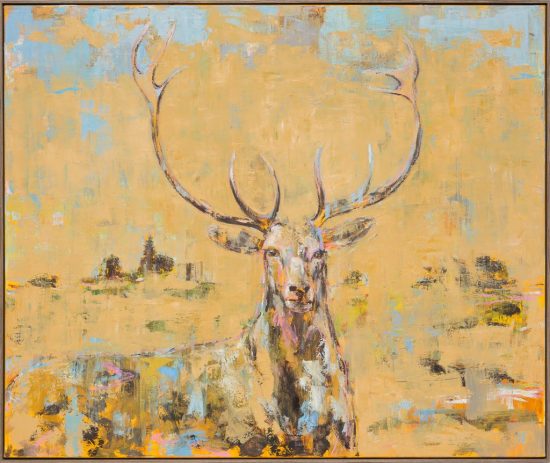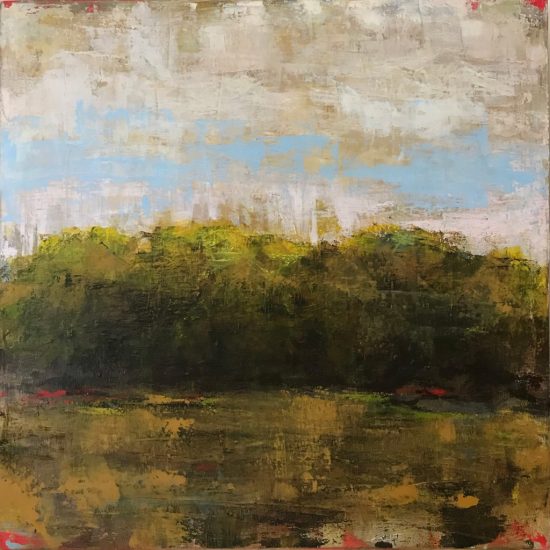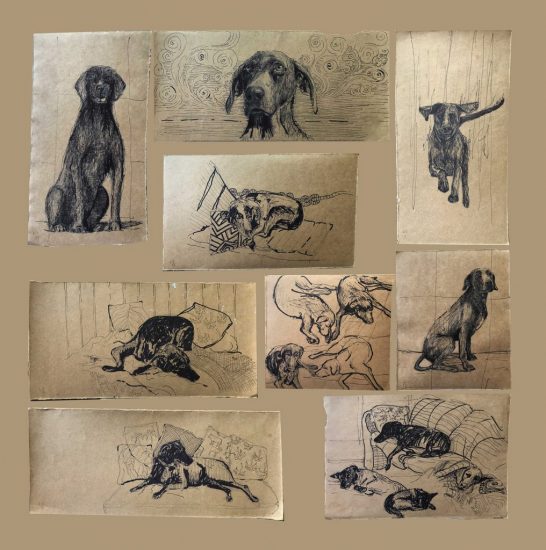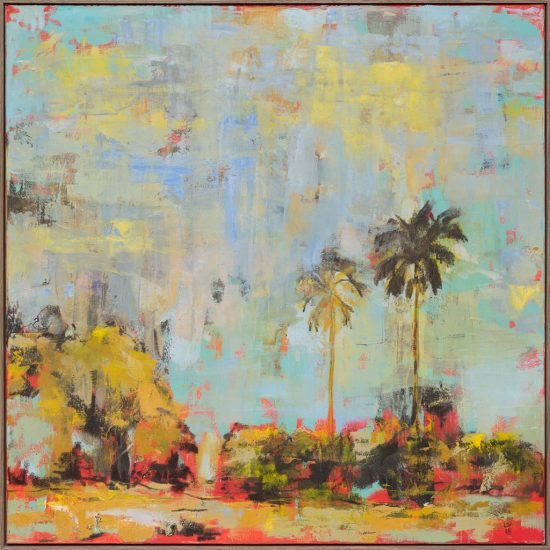With a major new body of work on show at Michael Reid’s Sydney gallery until March 31, Art Life editor Andrew Frost asked Lucy Vader about painting, the weather, and dogs…
Lucy Vader, Ineluctable grace, 2018, oil on canvas, 101.5 x 123 cm
Andrew Frost: Let’s start with talking about the surface of your paintings. Could you tell us how you go about building the image in your work – they have a very distinctive look.
Lucy Vader: There are a few reasons I paint the way I do.Years ago, before I started painting in earnest I asked Samantha Tidbeck, a Sydney artist, to teach me 15th century Cinquecento painting techniques from the Renaissance period, as a way in for me to begin working with oils. This technique, amongst other things, involved laying down a ground of mid-tone on to the canvas as initial preparation, and then modelling up, as it were, the subject in lead white paint as if it were a plaster cast, and then layering transparent pigments delicately until a nuanced subject appears, borne of complex pigment layers. Think Titian and Da Vinci. So, in other words, I never work on a white canvas.
The mid-tone canvas “ground” surface is traditionally usually an earth red, or a blue, or an emerald green, depending on what the intended subject is, and is meant to serve as an unpainted mid-tone in the finished composition. Remaining intentionally unpainted in areas of the finished work, the ground might perform the role of, for instance, a cheek hollow shadow between the lit area of a protruding cheekbone, and the receding depths of a neckline receding into shadow. This sort of unpainted breathing space in work excited me, and I saw the same technique again in the Impressionists, as well as in the brushwork of Velazquez. I instinctively felt the life and vitality that this sense of unfinished surface technique brought to the work.
Moving on from that Cinquecento learning, I discarded most of it, but kept elements of the open style, the coloured ground, and some of the figurative modelling. I work in a way that ends up almost fresco-like. I apply and remove paint, I attempt to keep the paint breathing and open, and I antagonise the surface before calming it to some sort of finished satisfaction. It’s the history of work in the layers and applying / removal that builds to a work of balance that finally stimulates a positive emotional response in me.
Keeping the layers open and revealing opposing colour in the history allows for a simultaneous colour vibration that can invoke a sense of true landscape colour whilst at the same time being completely impossible. Within the semi-chaos of the disrupted canvas surface I form subjects: anchors like figures, trees, horizons exactingly located within proportional constraints. It’s hard, because I don’t entirely know what I’m doing. I feel my way, painting and painting until I hit something, like I’m digging around in sand at the beach, looking for my car keys. It feels great when I find my car keys.
So the paint surface is always open, the edges never fully opaquely sealed, the bottom of the pictorial plane is always disintegrated and fragmented. This is because of three things I believe in: the painting must breathe; a fully sealed canvas is like death; and the disintegration reminds me that painting is an illusion – that Plato’s cave sort of idea, combined with that old id sensation of drawing stories on the cave wall, and the canvas being a movable cave wall.
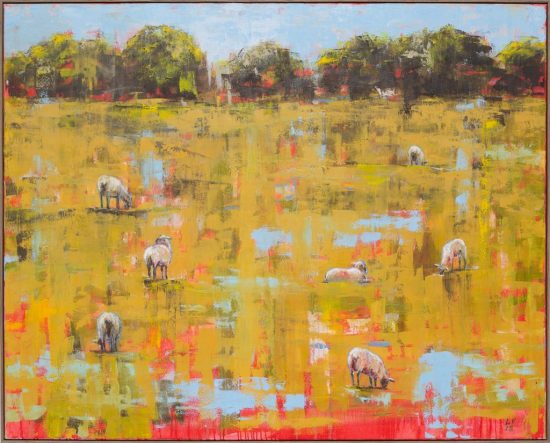
Lucy Vader, Rain Event (Predicted), 2018, oil on canvas, 122 x 152 cm
AF: What draws you to the subjects of your paintings? The weather, and rain in particular, seem to be key subjects for this group of paintings.
LV: My work is specific to our weather systems, and are rain dances for good rainfall, and the choirs to the landscape invoking good times. Even works with hints of dry are always about to be rejuvenated with rain. The weather has always been a component of much of my work. My first exhibition with Michael Reid Gallery featured sheep swimming across rivers, and it was a response to the drought-breaking epic floods that were spilling down from Far North QLD, and the Territory, back in 2010/11.
While many parts of Australia continue to struggle on in drought, it was Sth East Australia that had been in drought for 10 years from 2001 to 2010. Melbourne’s water supply was nearly dry. Goulburn had run out of water. Warragamba Dam was looking pretty shabby at 17%. We built nuclear fresh water-making machines to turn sea water to drinking water. Things were looking pretty grim. Then nature in her fickle way flooded the living buggery out of us and houses floated away, and dams filled up.
I had been particularly grumpy in the lead up to the drought breaker. I grew up in coastal country with regular rain. I lived for rain, and I still do. It has a range of levels of importance to me, and on a selfish level, it simply makes me happy. During the big drought (called the Millennium drought, and considered to be the worst since European settlement) from 2001 to 2010, I was in a relationship and his two children had been born at the beginning and middle of the drought – these Sydney city kids had not seen rain, not proper rain. That seemed surreal to me. As a rain addict, I was tetchy. As a country girl, I was uneasy. As an artist, it would appear I was about to paint out my feelings.
So the subjects in my paintings, while definitely intuitive, are responsive to the Australian climate and land. And who better to be the figurative element to experience our weather than the animals who we work with within it? Sheep, mainly, and cattle. Sheep are my chosen motif to anchor my expressive landscapes. So often unseen or unnoticed in the paddocks they populate, their forms continue to appeal to me to paint, and their intrinsic poetry continue to work for my unforced inspiration. I paint works of weather in private communion with the Bureau of Meteorology, and with the high and low pressure systems, and with troughs of precipitation. I paint the weather I want, the weather I have seen, and psychological landscapes that speak to the conditions of Australia.
Lucy Vader, When I close my eyes, 2018, oil on canvas, 50.5 x 50.5 cm
AF: There’s also an interesting play with scale in the series, do you make decision for their scale based on the subject?
LV: Scale is very important to me in my compositions. There are a series of proportional rules I abide by, and there is a variation of scale I like to move through across the range of works, rhythmically. It starts to sound like music, doesn’t it. Sound of colour and form is at play in my senses when I’m working. Tonal harmony in colour is like sound, and proportions can irritate-soothe like John Cage’s 4’33”, or build ecstatically like Ravel’s Bolero. Or somewhere in between.
With the scale in my work, I have always felt like I am shifting the lens closer or further away. It’s all about the horizon, and the ability to create an abstract colour field in the vertical sense, and a depth of space in the horizontal axis but from the viewer’s perspective. I hope my works can alternate between these two planes, between the upright abstraction, and the flat depth. Therefore, the low, the high, and the absent horizon all perform a role in facilitating my objective.
Up-close animal portraits are the zooming in, face-on, personal experience of the animals, who otherwise occupy my works indifferently to the gaze, backs turned, small in scale, peacefully grazing in the abstract colour field we call the world.
Compositionally I work in thirds, I have an aversion to symmetry, I believe there should be nothing in the middle, and I hate even numbers.
Lucy Vader,The many states of dog, 2018, ink on paper, comprising nine drawings, 87 x 87 cm
AF: What’s the relationship between the drawings and the paintings – are they separate, or complimentary in their subject of [mainly] dogs?
LV: Drawing is like going to the gym for artists. Its value is variable, but drawing is hard, and it’s vulnerable. There is nowhere to hide in drawing. There is the immediate sense of the hand in drawing – and in mine it is imperfect. I do quick scribbles to capture essence, and sustained drawings to capture form. I think there is more feeling in the quicker drawings, and more scope for story telling in the more sustained drawings.
The dog drawings in my current exhibition are both separate and complimentary to the paintings. Like a bonus section. I can be quite pedantic in my work: I paint mostly sheep and the rain, yet if I draw it is mostly dogs.
I grew up as a child immersed in the Impressionists, in particular the Fauves. With drawing, I grew up with David Hockney’s Grimm fairy tale etchings, Matisse’s simple lines, New York artist Rombola’s drawings, and Edward Burra’s work, as well as Indian drawings from the 1800s, and classical Japanese art, along the lines of Toshusai Sharaku.
I think these artists may have influenced my drawing style and output to a degree due to exposure and endless drawing as a child, and my intuitive preference to drawing subject errs toward the canine.
Lucy Vader, Rise said the sun, 2018, oil on canvas, 101.5 x 101.5 cm
AF: What’s your personal relationship to the work over time? Is there a continuity for you in how the treatment has evolved?
LV: Well, I feel very fortunate to have been painting as the main occupation of my life non-stop for eight years now. I have approached every blank canvas with the same approach since the beginning, and the changes are occurring by themselves as I evolve, but also as the weather patterns in Australia recite their variations. The work used to be more sheep-focussed, and the sheep with the object-experiencer of weather implications. I find now that the weather and the landscape is more the dominant subject in my work, and the animal participant has receded from the focus, but remains an important component of my output.
Lucy Vader’s Big Rain Has Got To Come is at Michael Reid Sydney until March 31.
